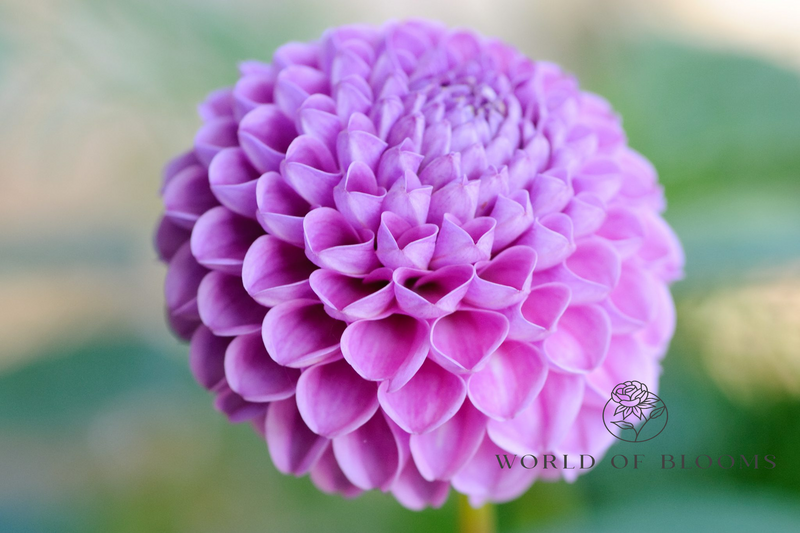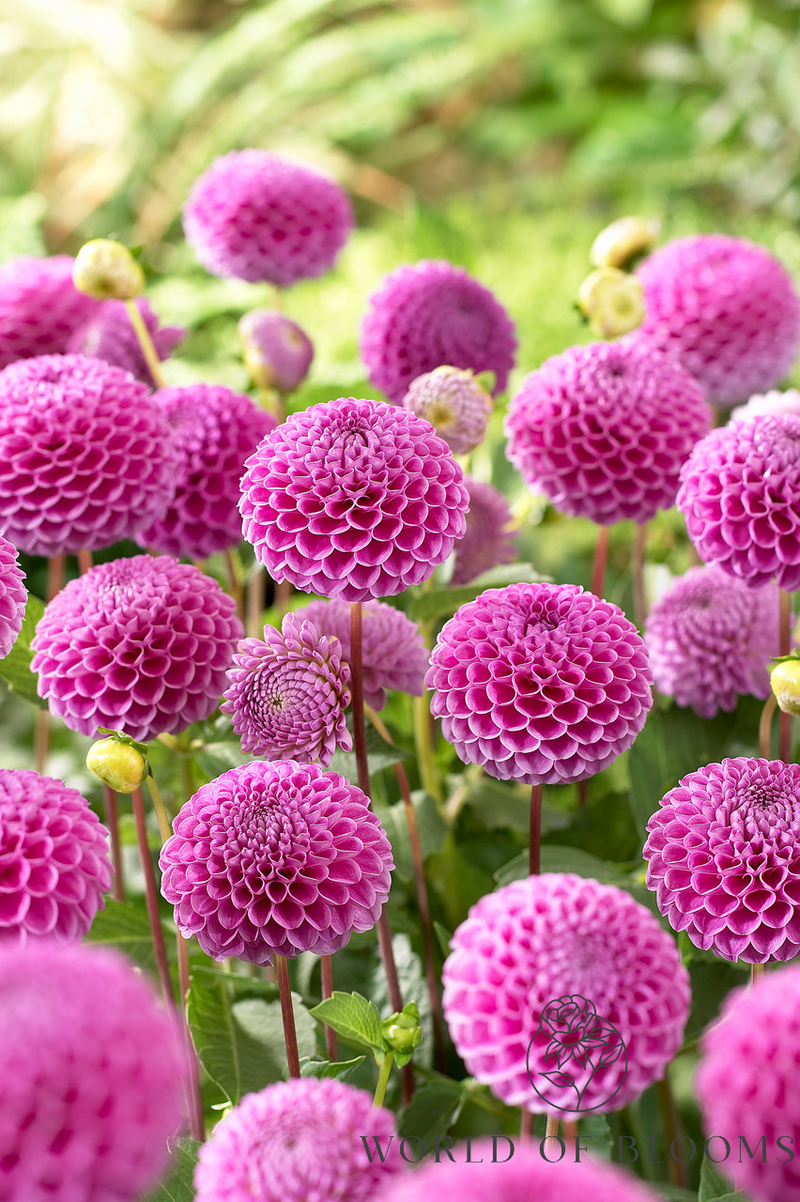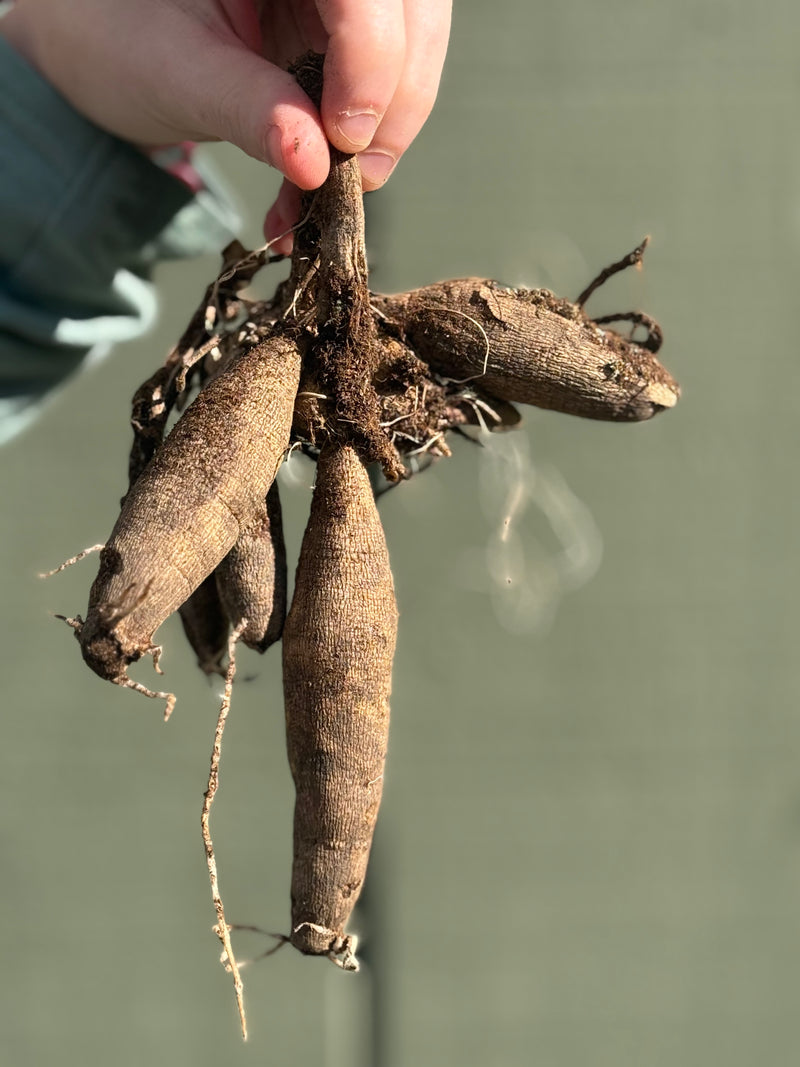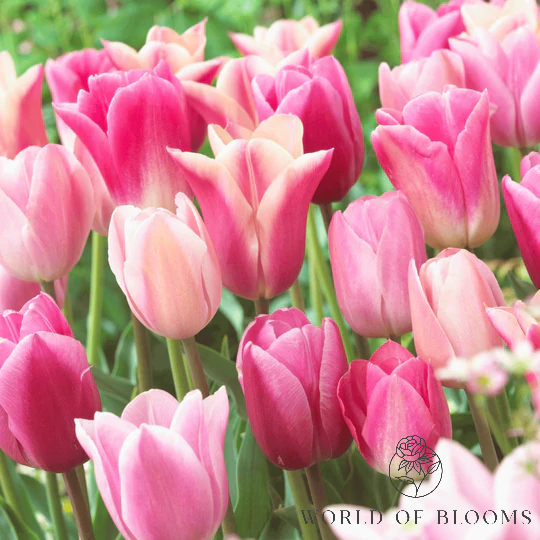Dahlia Pompon 'Franz Kafka'
Couldn't load pickup availability
Dahlia Pompon 'Franz Kafka' is a visually stunning and versatile dahlia variety, known for its perfect, ball-shaped blooms and rich, deep magenta color. Its small but dense flowers make it a standout in both garden beds and floral arrangements. With a compact growth habit, it is ideal for smaller gardens, containers, or the front of borders, and it thrives in full sun and well-drained soil. The long bloom period, coupled with its attractive shape and color, ensures that this dahlia will be a favorite for gardeners and flower arrangers alike. With proper care, including regular watering, deadheading, and occasional staking, 'Franz Kafka' will provide months of beauty and color in your garden.
Zones: 3 - 11
General Characteristics:
- Type: Pompon Dahlia
- Flower Shape: The blooms of 'Franz Kafka' are characteristic of the Pompon variety, with small, round, ball-like flowers that are almost perfectly spherical in shape. Each flower is densely packed with tightly arranged petals, giving it a full, plush appearance. The spherical shape of the blooms is highly attractive and adds a charming element to gardens or arrangements.
- Bloom Color: The color of 'Franz Kafka' is a rich, deep magenta red, with a slight hint of purple, giving it a luxurious, almost velvety appearance. The deep red color can sometimes show subtle variations of purple depending on the lighting, adding complexity and depth to the overall color. This bold, dramatic hue makes it an excellent choice for adding color contrast in gardens or floral displays.
- Flower Size: As a Pompon dahlia, the flowers of 'Franz Kafka' are relatively small, usually reaching around 2 to 3 inches (5 to 7 cm) in diameter. Despite their small size, the blooms are dense, with an abundance of petals that create a plush, ball-shaped effect. The compact nature of the flowers makes them ideal for adding texture and variety in arrangements.
- Petal Texture: The petals of 'Franz Kafka' are soft, smooth, and slightly waxy in texture, giving them a delicate appearance. The petals curve inward toward the center of the flower, contributing to its compact, spherical shape. Their texture helps the flowers maintain their form even under less-than-ideal weather conditions.
Plant Characteristics:
- Height: Dahlia 'Franz Kafka' is a compact plant, typically growing to a height of around 2 to 3 feet (60 to 90 cm). This makes it ideal for smaller spaces, containers, or the front of garden borders, where its neat and tidy habit can be fully appreciated.
- Spread: The plant has a moderate spread, usually around 18 to 24 inches (45 to 60 cm). Its bushy growth habit, with many branching stems, ensures a full, lush appearance that enhances the visual impact of the blooms.
- Foliage: The foliage of 'Franz Kafka' is dark green with a slightly glossy texture. The leaves are narrow, pointed, and slightly serrated, creating a nice contrast with the deep red flowers. The dark green leaves frame the blooms and contribute to the overall elegant appearance of the plant.
- Growth Habit: 'Franz Kafka' has an upright growth habit with multiple branching stems that create a bushy, compact form. The plant’s structure helps to support the small but dense blooms, which can sometimes require slight staking or support to prevent them from toppling over under the weight of the flowers, especially in windy conditions.
Growing Conditions:
- Sunlight: Like most dahlias, 'Franz Kafka' requires full sun to thrive. It needs at least 6 hours of direct sunlight each day to grow well and produce its characteristic dense blooms. Sunlight helps the plant produce healthy foliage and vibrant flowers.
- Soil: This variety prefers well-draining, fertile soil, ideally rich in organic matter. The soil should have a slightly acidic to neutral pH (6.0 to 6.5). Adding compost or well-rotted manure to the soil will improve its fertility and structure, promoting strong growth and vibrant flowers.
- Watering: Dahlia 'Franz Kafka' prefers consistent moisture but does not like to sit in waterlogged soil. Ensure that the soil is moist but well-drained. Water the plant at its base and avoid overhead watering, which can help prevent fungal diseases and encourage healthy root growth.
- Hardiness Zone: Dahlia 'Franz Kafka' is best suited for USDA hardiness zones 8 to 10. In colder climates, the tubers should be lifted before the first frost, stored in a dry, cool place over the winter, and replanted in the spring when the risk of frost has passed.
Blooming Period:
- Flowering Time: Dahlia 'Franz Kafka' generally begins to bloom in mid-summer, around July, and continues to flower until the first frost. This extended blooming period makes it a great choice for gardeners who want long-lasting color and interest in their gardens.
- Pollinators: The flowers of 'Franz Kafka' are attractive to various pollinators, including bees, butterflies, and even hummingbirds. These insects help pollinate the blooms, contributing to a thriving and healthy garden ecosystem.
Care and Maintenance:
- Deadheading: Regular deadheading (removing spent flowers) encourages the plant to produce more blooms, keeping it looking neat and tidy. Removing old flowers also helps the plant focus energy on producing fresh blooms rather than seeds.
- Fertilization: A balanced fertilizer can be applied in early spring to encourage strong growth. Once the plant starts blooming, a fertilizer high in phosphorus and potassium can help promote larger, more vibrant flowers. Avoid using fertilizers with excessive nitrogen, as it can lead to more foliage growth at the expense of flowers.
- Pest and Disease Control: 'Franz Kafka' is relatively resistant to pests, but it can occasionally attract aphids, slugs, and snails. Keeping the plant clean and inspecting it regularly for signs of pests can help prevent infestations. Organic pest control methods, like neem oil or insecticidal soap, can be effective when needed.
- Staking: While the plant is relatively compact, the heavy blooms may require some support, especially in windy conditions. A simple stake or plant support can keep the plant upright and ensure the flowers do not droop or fall over.
Uses:
- Garden Beds: Dahlia 'Franz Kafka' is a great addition to garden beds, particularly in smaller spaces or as part of a mixed border. Its compact size and dense blooms make it ideal for creating color contrast and texture.
- Containers: Due to its compact size, 'Franz Kafka' is an excellent choice for containers or patio gardens. It will thrive in a large pot and provide color and interest in areas where ground space is limited.
- Cut Flowers: The small, spherical flowers of 'Franz Kafka' make it a wonderful choice for cut flowers. The blooms last well in a vase and are excellent for use in floral arrangements, particularly in bouquets with other small-flowered varieties or as accents in larger arrangements.
- Landscaping: In landscaping, 'Franz Kafka' works well in formal and informal garden settings. It can be used in group plantings, container gardens, or even as an edging plant due to its compact size and vibrant color.
Planting Instructions
1. Choosing the Right Location
Dahlias require specific growing conditions to thrive, so selecting the right spot is key:
- Sunlight: Dahlias love full sun. Choose a location that receives at least 6-8 hours of direct sunlight each day. The more sun they get, the better the blooming.
- Soil: Well-drained, fertile soil is essential. Dahlias do best in slightly acidic to neutral soil (pH 6.0 to 7.0). If your soil is heavy clay or drains poorly, amend it with organic matter (like compost) to improve drainage and fertility.
- Protection from Wind: Although dahlias are relatively tall and sturdy, they can be vulnerable to strong winds. Plant them in a sheltered spot to prevent breakage or damage to the flowers.
2. When to Plant Dahlias
Dahlias are warm-season flowers and should be planted once the threat of frost has passed and the soil has warmed up. In most regions, this means planting them in late spring, typically around late April to early May, after the last frost date.
- Soil Temperature: The ideal soil temperature for planting dahlia tubers is around 60°F (15°C). If the soil is too cold, the tubers may rot before they have a chance to sprout.
3. Preparing the Soil
Good soil preparation helps dahlias grow strong and healthy:
- Amend the Soil: Before planting, work compost or well-rotted manure into the soil. This adds nutrients and helps with drainage.
- Loosen the Soil: Dahlias have tubers that need to spread out, so make sure the soil is loose, not compacted.
- Add Fertilizer: Mix a slow-release balanced fertilizer or one specifically designed for flowering plants into the soil before planting to give your dahlias a nutrient boost.
4. Planting the Tubers
Once the soil is prepared, it's time to plant your dahlia tubers.
- Spacing: Dahlias should be spaced about 18-24 inches (45-60 cm) apart, depending on the variety. Taller varieties may need more space, while compact varieties can be planted a bit closer together.
- Planting Depth: Dig a hole or trench around 6 inches (15 cm) deep. Place the tuber in the hole with the "eyes" (small, bud-like protrusions) facing upward. If you’re planting multiple tubers, make sure there is enough room for the tubers to spread out as they grow.
- Orientation: If the tuber has a noticeable direction (like a flat side), plant it so that the eyes are facing upward. If unsure, it’s fine to plant the tuber sideways or with the flat side facing down.
- Covering: Gently cover the tuber with soil, and water it well after planting. Avoid burying the tuber too deeply; about 6 inches is ideal. The soil should be loose enough to allow the tuber to sprout easily.
5. Watering and Mulching
- Watering: After planting, water the area thoroughly to settle the soil around the tuber. Keep the soil evenly moist, but not soggy, while the tubers are establishing themselves. Once the plants start growing, they need consistent moisture, especially during dry spells.
- Mulching: Apply a thin layer of mulch around the plants to help retain moisture and suppress weeds. Organic mulch like straw, leaves, or grass clippings works well. However, avoid placing mulch directly on the tubers.
6. Staking or Supporting Dahlias
Dahlias can grow tall, especially larger varieties, so they may need support:
- Staking: To prevent the stems from flopping over, you can insert stakes near the plants and tie the stems loosely to the stakes. This is especially important for tall varieties or those with large flowers.
- Cages: Another option is to use a wire cage around the plant to provide support as it grows. This keeps the plant upright and the flowers undamaged by wind or rain.
7. Fertilizing and Care During the Growing Season
Once your dahlias are planted, it’s important to feed and care for them as they grow:
- Fertilizing: After planting, you can give dahlias a light dose of a high-phosphorus fertilizer to encourage blooming. Later in the growing season, switch to a balanced fertilizer or one that is lower in nitrogen. Over-fertilizing with too much nitrogen can result in lush foliage but fewer flowers.
- Deadheading: Remove spent blooms regularly to encourage new flowers and keep the plant looking tidy.
- Pruning: Prune the stems lightly to encourage branching. If you're growing large varieties, you may want to pinch off the top few buds to encourage bushier growth.
8. Aftercare and Harvesting
- Watering: Ensure that dahlias receive regular watering throughout the growing season, especially when the weather is hot and dry. The soil should stay moist but not waterlogged.
- Cutting Flowers: Dahlias are wonderful cut flowers! If you want to enjoy them indoors, cut them in the early morning or evening when they’re freshest, and place them in water immediately.
9. Overwintering Dahlias (for cold climates)
- Digging Up Tubers: In colder climates (zones 7 and below), you’ll need to dig up dahlia tubers before the first frost hits. Carefully lift the tubers with a spade or fork, being careful not to damage them. Trim the foliage and let the tubers dry for a couple of days in a cool, dry place.
- Storage: After drying, store the tubers in a cool, frost-free location, like a basement or garage, in a box with peat moss, sawdust, or sand to keep them dry. Check on the tubers periodically to make sure they haven’t rotted.




Recently viewed








